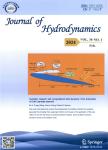MEASUREMENT OF SOLID SLURRY FLOW VIA CORRELATION OF ELECTROMAGNETIC FLOW METER,ELECTRICAL RESISTANCE TOMOGRAPHY AND MECHANISTIC MODELLING
MEASUREMENT OF SOLID SLURRY FLOW VIA CORRELATION OF ELECTROMAGNETIC FLOW METER,ELECTRICAL RESISTANCE TOMOGRAPHY AND MECHANISTIC MODELLING作者机构:Institute of Mechanics Chinese Academy of Sciences Beijing 100190 China School of Process Environmental and Materials Engineering University of Leeds Leeds UK
出 版 物:《Journal of Hydrodynamics》 (水动力学研究与进展B辑(英文版))
年 卷 期:2009年第21卷第4期
页 面:557-563页
核心收录:
学科分类:0810[工学-信息与通信工程] 08[工学] 080401[工学-精密仪器及机械] 0804[工学-仪器科学与技术] 080402[工学-测试计量技术及仪器] 0835[工学-软件工程] 081002[工学-信号与信息处理] 081102[工学-检测技术与自动化装置] 0811[工学-控制科学与工程]
主 题:slurry measurement Electrical Resistance Tomography (ERT) Electromagnetic Flow Meters (EFM) in-situ mean volumetric fraction slip velocity
摘 要:The study presented here was carried out to obtain the actual solids flow rate by the combination of electrical resistance tomography and electromagnetic flow meter. A new in-situ measurement method based on measurements of the Electromagnetic Flow Meters (EFM) and Electrical Resistance Tomography (ERT) to study the flow rates of individual phases in a vertical flow was proposed. The study was based on laboratory experiments that were carded out with a 50 mm vertical flow rig for a number of sand concentrations and different mixture velocities. A range of sand slurries with median particle size from 212 μm to 355 μm was tested. The solid concentration by volume covered was 5% and 15%, and the corresponding density of 5% was 1078 kg/m^3 and of 15% was 1238 kg/m^3. The flow velocity was between 1.5 m/s and 3.0 m/s. A total of 6 experimental tests were conducted. The equivalent liquid model was adopted to validate in-situ volumetric solids fraction and calculate the slip velocity. The results show that the ERT technique can be used in conjunction with an electromagnetic flow meter as a way of measurement of slurry flow rate in a vertical pipe flow. However it should be emphasized that the EFM results must be treated with reservation when the flow pattern at the EFM mounting position is a non-homogenous flow. The flow rate obtained by the EFM should be corrected considering the slip velocity and the flow pattern.



